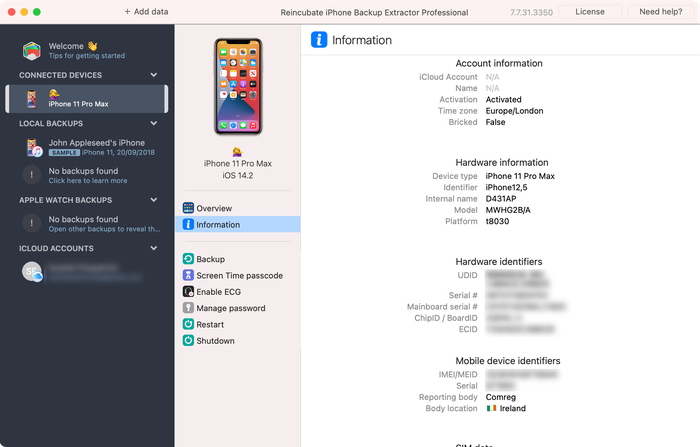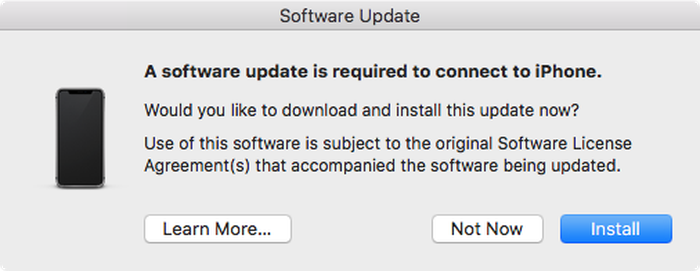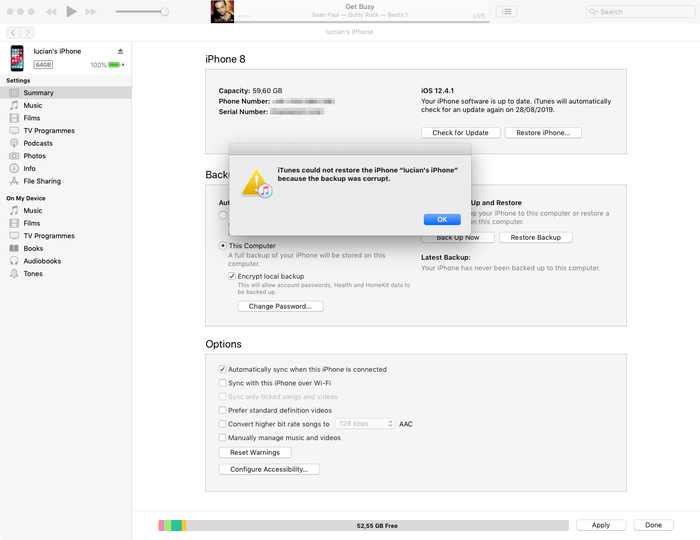iPhone backup & restore FAQ
With over a decade's experience helping with iPhone and iPad backups, we've rounded up some of our top tips.
- How can I access my WhatsApp `ChatStorage.sqlite` file?
- Should I use local iTunes backups instead of iCloud backups?
- Where are iTunes backups stored?
- When I look in my iTunes backup folder I just see random files, which is which? What are those files in my iTunes backup folder?
- iTunes won't restore my iPhone backup
- Can I recover a corrupt iTunes backup?
- How can I recover lost files after a failed iOS update
- What's in an iOS backup?
- How can I speed up a slow iTunes backup process?
- Can I get data from iPad backups and iPod Touch backups?
- Can I find my phone number, IMEI or serial in an iTunes backup?
- Is it possible to extract data from a very old iOS backup, like iOS 3?
- How can I edit an iTunes backup?
- Can I copy a Windows iTunes backup to a Mac, or vice versa? Are iTunes backups portable?
- Can I back up with iTunes wirelessly?
- How can I browse iTunes backups?
- Can I restore a backup from one iOS version to another? Can you convert iTunes backup versions?
- Can I debug my app using iPhone backup data?
- How to fix “an error occurred” backup error
- How to fix “iPhone was disconnected”
- How to fix “A software update is required to connect to iPhone”
- How to fix “iPhone could not be restored. An unknown error occurred”
- How to fix “iTunes doesn't recognise your device”
- How to fix “iTunes backup session failed”
- How to fix “iPhone backup was corrupt or not compatible"
How can I access my WhatsApp `ChatStorage.sqlite` file?
You can access your ChatStorage.sqlite file using "Expert mode" as described in the steps above, and iPhone Backup Extractor enables you to get that file both from iTunes and iCloud backups. You can use this when migrating your data to Android. We publish a guide to getting ChatStorage here.
Should I use local iTunes backups instead of iCloud backups?
You can copy and save the data on your iPhone or iPad by backing up in iCloud or iTunes, and we explore the differences between iTunes and iCloud backups in more detail in our knowledge-base. Check it out, as we also talk about how to back up your iOS device.
Here's how to recover your iTunes iOS backup data without iTunes -- or the iOS device itself.
Where are iTunes backups stored?
The default iTunes backup location depends on whether you're using a PC or Mac. iTunes backups can be found in the following directories:
-
On Windows 10 and recent versions of Windows, backups are stored in:
\Users\(username)\AppData\Roaming\Apple Computer\MobileSync\Backup\ -
On Macs, backups are stored in:
\Users\(username)\Library\Application Support\MobileSync\Backup\
There are a few special cases. For instance, the Windows Store version of iTunes uses a different location, and so does iTunes on Windows XP. We maintain the latest default iTunes backup locations here, and have instructions on how to change the default iTunes backup folder.
When I look in my iTunes backup folder I just see random files, which is which? What are those files in my iTunes backup folder?
iTunes backup folders contain files named according to hex-encoded SHA-1 hashes. Their filenames can differ based on the type of data and the version of iOS that created the backup.
We maintain an up-to-the-minute summary of these iTunes backup files here but have included a short summary below for recent versions of iOS:
| Contents | Real filename | Backup filename |
|---|---|---|
| SMS | sms.db |
3d0d7e5fb2ce288813306e4d4636395e047a3d28 |
| Contacts | AddressBook.sqlitedb |
31bb7ba8914766d4ba40d6dfb6113c8b614be442 |
| Calendar | Calendar.sqlitedb |
2041457d5fe04d39d0ab481178355df6781e6858 |
| Notes | NoteStore.sqlite |
4f98687d8ab0d6d1a371110e6b7300f6e465bef2 |
| Call history | call_history.db |
2b2b0084a1bc3a5ac8c27afdf14afb42c61a19ca |
iTunes won't restore my iPhone backup
If iTunes won't restore your iPhone backup, it probably means its corrupt.
We publish a list of steps for diagnosing problems restoring iTunes backups. If that doesn't resolve the problem, see the next question.
Can I recover a corrupt iTunes backup?
Yes. We've got a comprehensive guide on how to repair corrupt backups and recover your data. If you're still stuck, reach out to our support team as we can probably help further. There's a lot of fiddly stuff we can help you with.
How can I recover lost files after a failed iOS update
One of the most common causes for iPhone data loss is a failed iOS update. The steps in the first part of this guide will take you through pulling files from your iTunes backup.
Depending on where the process went wrong, you may need to restore your phone from a backup before starting the update process again. Good luck -- and don't forget to reach out to our support team if you get stuck.
What's in an iOS backup?
The contents of an iOS backup vary, depending on whether it is encrypted, made locally (with iTunes or macOS) or stored in iCloud.
In most cases, contacts, notes, photos, calendar, texts, and so on, are backed up. We've got a concise summary of just what is and isn't in an iTunes backup.
How can I speed up a slow iTunes backup process?
We once had a user write in after his backup had taken more than 36 hours. That's crazy — and it led us to publish an article on how to speed up a slow iTunes backup.
Can I get data from iPad backups and iPod Touch backups?
Absolutely, yes! You'll see we tend to write about iPhone backups, but the format and functionality is exactly the same for iPad and iPod Touch backups. Anything we describe for iPhone backups will also work for iTunes backups created for the iPad or iPod Touch.
Can I find my phone number, IMEI or serial in an iTunes backup?
You certainly can. These are all shown under the "Info" tab of iPhone Backup Extractor. You can see IMEI, serial, and a range of other fields. You can read about all of that data in our explainer of the "Info" view.

Is it possible to extract data from a very old iOS backup, like iOS 3?
Yes. We painstakingly support backups from every version of iOS. We started back in 2008, after our founder lost his data with an upgrade to iOS 2. Phew! If you get stuck on an older version, get in touch with us.
How can I edit an iTunes backup?
iPhone Backup Extractor lets you edit any iTunes backup: by using "Expert mode", you can edit or replace any file in your backup, or add new ones.
Can I copy a Windows iTunes backup to a Mac, or vice versa? Are iTunes backups portable?
Yes, iTunes backups are created in the same format by Macs and Windows, and can be moved from one to another. You can even put them in Dropbox or on a shared drive.
Can I back up with iTunes wirelessly?
To get backups working with iTunes over Wi-Fi, you need run through these steps:
- Connect with USB and open the iPhone section on iTunes.
- Tick “Sync with this iPhone over Wi-Fi”.
- Ensure “This computer” is the backup location, not “iCloud”.
- Hit “Done” at the bottom of iTunes.
We've got more detailed instructions on how to do this here.
How can I browse iTunes backups?
iPhone Backup Extractor has a free iTunes backup browser built-in. Once you load it (see our guide) it'll automatically show all of your iTunes backups and let you browse them.
Can I restore a backup from one iOS version to another? Can you convert iTunes backup versions?
You can restore most older backups to a device running a newer version of iOS.
You can't restore a newer backup to a device running an older version of iOS, but in some cases you can edit and downgrade the backup's iOS version. We've got a detailed guide on how to restore an iOS backup to an earlier version of iOS.
Can I debug my app using iPhone backup data?
You may sometimes receive reports from your customers of problems that are hard to troubleshoot over email. It can be a pain to really get to the bottom of the problem without access to the app data stored on the customer's device.
There is, however, a way your customer can send you that data: by syncing their iPhone with their computer and sending you the app's data file in the iTunes backup.
To do this, you'll need to know the name of the app's file in the backup. If you have a look in your own iPhone backup folder, you should be able to find it with a string search tool such as grep by searching for a string you know will be in the file.
Once you know the name of the file, simply ask your customers to send you their copy of that file when they have a hard-to-diagnose problem. An easy way for them to get the file is for them to extract it using a tool such as iPhone Backup Extractor.
If you have any other good tips for debugging tricky iPhone app issues, then do share them in the comments. Happy troubleshooting!
How to fix “an error occurred” backup error
Error message:
iTunes could not back up the iPhone because an error occurred.
This vague-sounding error can be caused by a number of different issues. To fix, try the following:
- If you're running Windows, make sure you have the latest version of iTunes installed on your computer
- Restart your computer and iPhone
- Make sure you have enough space on your computer to store the new backup
- Move or rename previous iPhone backups
How to fix “iPhone was disconnected”
Error messages:
iTunes could not restore the iPhone because the iPhone disconnected.
iTunes could not back up the iPhone because the iPhone disconnected.
The error message is commonly caused by a connection issue. To troubleshoot your connection, try using a different USB cable, and connect it directly to your computer, rather than via a hub or other device (such as a keyboard). You should also try using different USB ports on your computer.
If the error message is not caused by a connection issue, try restarting your computer and rebooting your iPhone. You can also try resetting your iPhone’s network settings (Settings → General → Reset → Reset Network Settings - though be aware that this will delete your WiFi passwords) and turning on both Airplane mode and Low Power Mode.
Some users have also found that they can avoid this error message by backing up their iPhone without encrypting the backup.
How to fix “A software update is required to connect to iPhone”
Error message:
A software update is required to connect to iPhone
This message can be confusing as it doesn’t specify what needs updating; is it the iPhone, or your PC or Mac? Apple has clarified that it's your computer that this message is referring to.

Users will often receive this message if they are running a beta version of iOS, but aren't running the equivalent iTunes beta. If that's the case, hitting the "Install" button won't work. It'll say it's downloading an update for a while before it fails, saying "Installation failed. Can't install the software because it is not currently available from the Software Update server." The solution is to install the latest beta of iTunes.
How to fix “iPhone could not be restored. An unknown error occurred”
Error message:
The iPhone could not be restored. An unknown error occurred
This error is a catch-all for a range of different problems. Depending on the underlying cause, there are a number of possible solutions:
- Using the latest version of iTunes (and not a beta!) is a good place to start -- upgrade, if you're not already using the latest version.
- Windows users can find a reboot helps to resolve this issue (if you follow the above and upgrade iTunes, you'll need to reboot anyway)
- Completely resetting the phone and running a restore in DFU mode
- Apple have a short document with further tips for this error
If these tips don’t work, find out how to fix a corrupt backup here .
How to fix “iTunes doesn't recognise your device”
Error message:
iTunes could not restore because iTunes doesn't recognise your device
To fix this error message, check you are using the latest version of iTunes, that your USB cable is connected properly (and not damaged), and you don't have any third-party software interfering with iTunes.
If you’ve checked these and are still getting the error message, this issue can usually be resolved by using recovery mode. Recovery mode will erase your device and restore it: if you previously synced with iTunes or iCloud you'll be able to restore from a backup after recovery.
Find out how to fix a corrupt backup here
The worst case is that there's a fundamental problem with the iOS device you're connecting. If you have a spare device try using it to restore your backup.
How to fix “iTunes backup session failed”
Error message:
iTunes could not restore [iPhone] because the backup session failed
This error tells you that you are dealing with a corrupt or unfinished iTunes backup. Find out how to fix a corrupt backup here
How to fix “iPhone backup was corrupt or not compatible"
Error message:
iTunes could not restore the iPhone [iPhone] because the backup was corrupt or not compatible with the iPhone that is being restored.

This message is straightforward and most likely tells you you're dealing with a corrupt backup. Every now and then, when iTunes or Finder backs up your iPhone or iPad, the process may fail without an error message, and you won’t find out until you try to restore your backup. Find out how to fix a corrupt backup here
Your backup might not necessarily be corrupt, however, as the same error message is shown when your iTunes backup is not compatible with the device that is being restored. For example, you can't restore an newer iOS backup to an older iOS device.
We’ve got a guide to upgrade or downgrade your iPhone your backup here. Alternately, you could:
- Restore it to a separate device running the version of iOS it was made with (you can see which version of iOS created a backup using iPhone Backup Extractor)
- Upgrade that device
- Back up the device again, creating a new and upgraded backup
